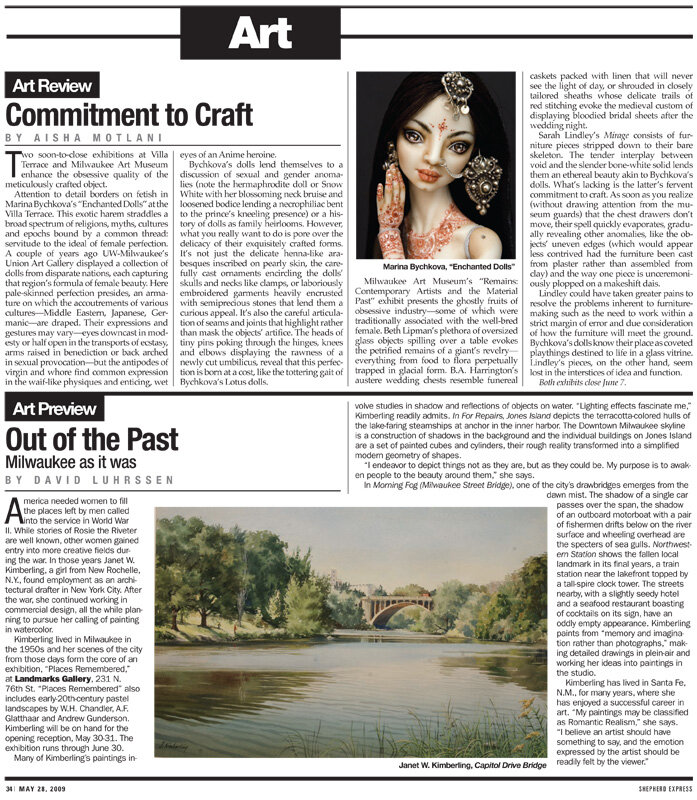2009- Shepherd Express, May 28-June 3, p34. Milwaukee, USA.
Commitment to Craft: Art Review
By Aisha Motlani
Two soon-to-close exhibitions at Villa Terrace and Milwaukee Art Museum enhance the obsessive quality of the meticulously crafted object.
Attention to detail borders on fetish in Marina Bychkova’s “Enchanted Dolls” at the Villa Terrace. This exotic harem straddles a broad spectrum of religions, myths, cultures and epochs bound by a common thread: servitude to the ideal of female perfection. A couple of years ago UW-Milwaukee’s Union Art Gallery displayed a collection of dolls from disparate nations, each capturing that region’s formula of female beauty. Here Western, pale-skinned perfection presides, an armature on which the accoutrements of various cultures-Middle Eastern, Japanese, Germanic-are draped. Their expressions and gestures may vary-eyes downcast in modesty or half open in the transports of ecstasy, arms raised in benediction or back arched in sexual provocation-but the antipodes of virgin and whore find common expression in the waif-like physiques and enticing, wet eyes of an Anime heroine.
Bychkova’s dolls lend themselves to a discussion of sexual and gender anomalies (note the hermaphrodite doll or Snow White with her blossoming neck bruise and loosened bodice lending a necrophiliac bent to the prince’s kneeling presence) or a history of dolls as family heirlooms. However, what you really want to do is pore over the delicacy of their exquisitely crafted forms. It’s not just the delicate henna-like arabesques inscribed on pearly skin, the carefully cast ornaments encircling the dolls’ skulls and necks like clamps, or laboriously embroidered garments heavily encrusted with semiprecious stones that lend them a curious appeal. It’s also the careful articulation of seams and joints that highlight rather than mask the objects’ artifice. The heads of tiny pins poking through the hinges, knees and elbows displaying the rawness of a newly cut umbilicus, reveal that this perfection is born at a cost, like the tottering gait of Bychkova’s Lotus dolls.
Milwaukee Art Museum’s “Remains: Contemporary Artists and the Material Past” exhibit presents the ghostly fruits of obsessive industry-some of which were traditionally associated with the well-bred female. Beth Lipman’s plethora of oversized glass objects spilling over a table evokes the petrified remains of a giant’s revelry-everything from food to flora perpetually trapped in glacial form. B.A. Harrington’s austere wedding chests resemble funereal caskets packed with linen that will never see the light of day, or shrouded in closely tailored sheaths whose delicate trails of red stitching evoke the medieval custom of displaying bloodied bridal sheets after the wedding night.
Sarah Lindley’s Mirage consists of furniture pieces stripped down to their bare skeleton. The tender interplay between void and the slender bone-white solid lends them an ethereal beauty akin to Bychkova’s dolls. What’s lacking is the latter’s fervent commitment to craft. As soon as you realize (without drawing attention from the museum guards) that the chest drawers don’t move, their spell quickly evaporates, gradually revealing other anomalies, like the objects’ uneven edges (which would appear less contrived had the furniture been cast from plaster rather than assembled from clay) and the way one piece is unceremoniously plopped on a makeshift dais.
Lindley could have taken greater pains to resolve the problems inherent to furniture-making such as the need to work within a strict margin of error and due consideration of how the furniture will meet the ground. Bychkova’s dolls know their place as coveted playthings destined to life in a glass vitrine. Lindley’s pieces, on the other hand, seem lost in the interstices of idea and function.
Both exhibits close June 7.


